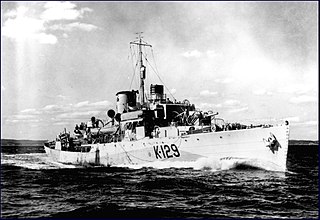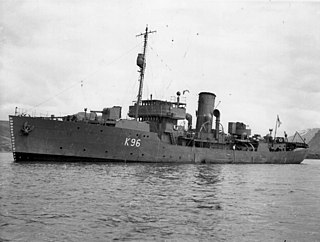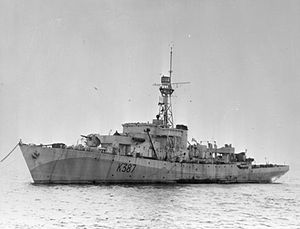
The Castle-class corvette was an ocean going convoy escort developed by the United Kingdom during the Second World War. It was the follow-on to the Flower-class corvette, and designed to be built in shipyards that were producing the Flowers. The Castle-class was a general improvement over the smaller Flowers which were designed for coastal rather than open ocean use.

HMS Odzani (K356) was a River-class frigate that served in the Royal Navy.
When the United States entered World War II at the end of 1941, the United States Navy found itself deficient in ocean escort-type vessels. A crash building program was instituted; but, to meet more immediate needs, the government contracted with shipbuilding firms in England and Canada to build Flower-class corvettes. Vim (PG-99) was one of those British-type escorts. She was launched on 1 April 1943 at the Collingwood Shipyard in Collingwood, Ontario. Nine days later, however, she was transferred to the Royal Navy under the terms of the lend-lease agreement in return for another Flower-class corvette then under construction in Canada. The British renamed her HMS Statice, and she served the Royal Navy under the name through World War II. On 21 June 1946, she was returned to the United States Navy. Though carried on the Navy list as PG-99, the corvette never saw active service with the United States Navy. She was sold on 7 May 1947. To whom she was sold and to what purpose she was put is unknown.
HMCS St. Thomas was a Castle-class corvette of the Royal Canadian Navy. She served during the Second World War in the Battle of the Atlantic, taking part in the sinking of the German U-boat U-877 in 1944. Initially ordered by the British Royal Navy as Sandgate Castle, the ship was transferred to Canada before completion. Following the war, the corvette was converted for mercantile use and renamed Camosun III, then Chilcotin and Yukon Star in 1958 before being broken up in Washington in 1974.

HMCS Agassiz was a Flower-class corvette of the Royal Canadian Navy. Named after the community of Agassiz, British Columbia, the ship was constructed by Burrard Dry Dock Co. Ltd. in North Vancouver, British Columbia and was launched on 15 August 1940. The corvette was commissioned on 23 January 1941 in Vancouver, British Columbia. The Flower class were initially designed for coastal service during the Second World War, but due to the demands of the Battle of the Atlantic, Agassiz was used primarily as an ocean escort for convoys crossing the Atlantic Ocean in engagements with German submarines. Following the war, the corvette was sold for scrap.

HMCS Royal Mount was a River-class frigate that served with the Royal Canadian Navy during the Second World War. She was used primarily as an ocean convoy escort in the Battle of the Atlantic. She was named for Mount Royal, Quebec and was constructed in Montreal by Canadian Vickers. The ship was laid down on 7 January 1944, launched on 15 April and commissioned on 25 August. After the war ended, the ship was placed in reserve until 1947, when the ship was sold for scrap.

HMS Oakham Castle was a Royal Navy corvette of the Castle class. Built as a convoy escort during the Second World War, it later became a weather ship before being scrapped in 1977.

HMS Hever Castle was a Castle-class corvette constructed for the British Royal Navy in the Second World War. Transferred to the Royal Canadian Navy before completion, the ship was renamed HMCS Copper Cliff and saw service as a convoy escort for the remainder of the war. Following the war, the vessel was sold for mercantile use and renamed Ta Lung, operating under a Chinese flag. In 1949, the ship was taken over by the Communist Chinese government, rearmed and renamed Wan Lee.

HMCS Hespeler was a Castle-class corvette of the Royal Canadian Navy which served during the Second World War as a convoy escort that was originally ordered as HMS Guildford Castle for the British Royal Navy but before completion was transferred and renamed. Following the war, the ship was sold for mercantile use, renamed Chilcotin in 1946, Capri in 1958, Stella Maris in 1960, and Westar in 1965. The ship was destroyed by fire in 1966 while at Sarroch, Sardinia. The hulk was taken to La Spezia, Italy where Westar was broken up.
HMS Norham Castle, initially named Totnes Castle, was a Castle-class corvette constructed for the British Royal Navy during the Second World War. Before completion, the ship was transferred to the Royal Canadian Navy, renamed HMCS Humberstone, and served the rest of the war as a convoy escort. Following the war, the corvette was sold for mercantile service, beginning as Taiwei in 1946 and ending as South Ocean in 1954. The ship was broken up in 1959.

HMS Woolvesey Castle, also spelled as Wolvesey Castle, was a Castle-class corvette constructed for the British Royal Navy during the Second World War. Before completion, the ship was transferred to the Royal Canadian Navy and was renamed HMCS Huntsville. Huntsville spent the rest of the war as a convoy escort. Following the war, the ship was converted for mercantile use and entered service as SS Wellington Kent in 1947. In 1951, the ship was renamed Belle Isle II. In 1960, Belle Isle II was sunk in a collision.
HMS Tamworth Castle was a Castle-class corvette that was ordered for the British Royal Navy during the Second World War. Before completion, the ship was transferred to the Royal Canadian Navy and renamed HMCS Kincardine, which used the corvette as a convoy escort for the rest of the war. Following the war, the ship was sold for mercantile use to French, then Moroccan interests and was renamed Saada in 1947.
HMS Walmer Castle was a Castle-class corvette constructed for the British Royal Navy during the Second World War. Before completion, the ship was transferred to the Royal Canadian Navy and renamed HMCS Leaside. The corvette was used as an ocean convoy escort during the war and was sold for mercantile use following it. The ship was purchased for use as a passenger ship and renamed Coquitlam, then in 1958, Glacier Queen. In 1970 Glacier Queen was acquired for use as a floating hotel in Alaska. The ship sank in 1978 and was raised and scuttled in Alaskan waters in 1979.

HMS Hedingham Castle was a Castle-class corvette constructed for the Royal Navy during the Second World War. Before being completed, the ship was transferred to the Royal Canadian Navy, renamed HMCS Orangeville and used as a convoy escort for the rest of the war. Following the war, the ship was sold to Chinese interests for mercantile use and renamed Ta Tung in 1946. In 1947, the ship was renamed Hsi Lin before being taken over by Nationalist China in 1951, rearmed and renamed Te An. Te An remained in service until 1967.

HMS Sherborne Castle was a Castle-class corvette constructed for the Royal Navy during the Second World War. Before completion, the ship was transferred to the Royal Canadian Navy and renamed HMCS Petrolia. During the war Petrolia saw service as a convoy escort. Following the war, the corvette was sold for mercantile use and renamed Maid of Athens in 1946 and in 1947, renamed Bharat Laxmi. The ship remained in service until 1965 when Bharat Laxmi was sold for breaking up.

HMS Pembroke Castle was a Castle-class corvette built for the British Royal Navy during the Second World War. Before completion, the ship was transferred to the Royal Canadian Navy and renamed HMCS Tillsonburg. Tillsonburg saw service as a convoy escort during the Second World War in the Battle of the Atlantic. Following the war, the corvette was converted for merchant use and sold to Chinese interests. The ship was renamed Ta Ting in 1946, Chiu Chin in 1947 before being taken over the Nationalist Chinese government in 1951, rearmed and renamed Kao An. The ship remained in service with the Republic of China Navy until being discarded in 1963.

HMS Aubrietia (K96) was a Flower-class corvette built for the Royal Navy (RN) from 1941-1946. She was active as a convoy escort in the Atlantic and Mediterranean. In May 1941, Aubrietia sighted and depth charged the German submarine U-110, leading to its capture and the seizure of a German Naval Enigma and its Kurzsignale code book.

HMS Delphinium (K77) was a Flower-class corvette built for the Royal Navy (RN) from 1940-1946. From 1941 to 1943 she was active in the Mediterranean as an escort to convoys supporting the Eighth Army and the invasion of Sicily. From mid-1943 onwards she was on convoy escort duties between Africa, the Mediterranean and the United Kingdom; and Atlantic convoys between North America and the United Kingdom. She escorted a total of 68 convoys.

HMS Serapis was an S-class destroyer of the British Royal Navy. The ship was built by Scotts Shipbuilding and Engineering Company from 1941 to 1943, and was launched on 25 March 1943 and completed on 25 December 1943.

HMS Poppy was a Flower-class corvette that served in the Royal Navy as a convoy escort during World War II.















